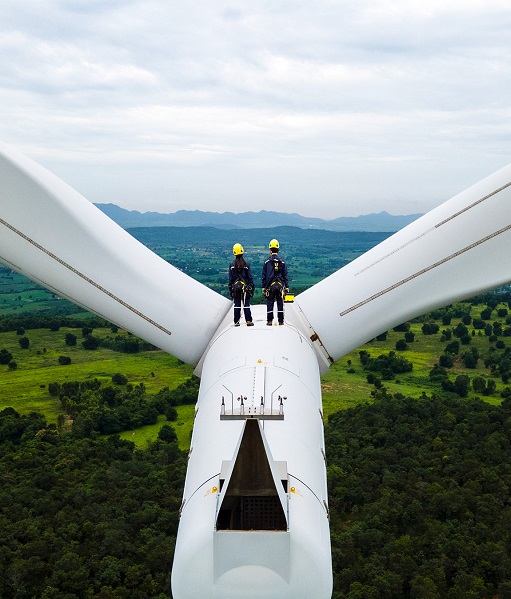
Defined
Contribution
A leading defined contribution (DC) investment-only provider
BlackRock manages the pensions savings, on behalf of our clients, for over 12 million people in the UK. We believe that people deserve financial security across their lifetime, and that retirement should be within reach for everyone.1
1BlackRock as of 31 December 2024.
Comparing the Australian and UK pensions landscapes
The UK pensions arena is undergoing huge transformational change, and it is often compared to Australia. So, we have built a three-part video series looking at the Australian pensions system, the key differences between the two countries and the key trends shaping the UK defined contribution landscape.
We advance sustainable investing because our conviction is it delivers better outcomes for investors

Dedicated research
Create, deliver, and scale material insights on sustainability.

Integrated process
Integrate Environmental, Social and Governance insights and data across asset classes and investment styles.

Sustainable solutions
Deliver sustainable solutions to help clients achieve their financial objectives.

Investment stewardship
Engage companies on sustainability issues that impact long-term performance.
ESG Investment Statements This information should not be relied upon as research, investment advice, or a recommendation regarding any products, strategies, or any security in particular. This is for illustrative and informational purposes and is subject to change. It has not been approved by any regulatory authority or securities regulator. The environmental, social, and governance (“ESG”) considerations discussed herein may affect an investment team’s decision to invest in certain companies or industries from time to time. Results may differ from portfolios that do not apply similar ESG considerations to their investment process.
Our investment capabilities
Defined contribution plans are becoming the primary way most people in the UK save for retirement. Our dedicated BlackRock defined contribution team can help you design a plan that’s built to achieve members’ retirement goals.
Target date strategies
Case study

Client Objective
The client’s primary objectives were twofold: they wished to evolve their default allocation and to simplify how the end result was presented to scheme members.
BlackRock Solution
Working closely with the client, platform and the consultant, BlackRock developed a glidepath, launched locally domiciled alternative investment funds, and delivered a structured solution for the client. The alternative investment funds are blended to provide target date funds, simplifying presentation to the scheme members, while maintaining all necessary sophistication under the hood.
As the scheme continues to grow, BlackRock continues its close relationship with the client to evolve the asset allocation over time.
Case studies are for illustrative purposes only; they are not meant as a guarantee of any future results or experience and should not be interpreted as advice or a recommendation.
Source: BlackRock as of September 25, 2023. (for case study)
Fixed Income
BlackRock offers a comprehensive fixed income platform, managing assets across the entire fixed income spectrum – from public to private, fundamental & systematic, active & index – to help deliver better outcomes, convenience, value, and transparency for our clients.
Multi-Asset Strategies and Solutions (MASS)
We help clients create customised portfolios to meet their end goals. Clients access the breadth of BlackRock’s platform, including our index, factor, alpha-seeking, and open-architecture capabilities.
Index investing
For UK institutional investors, the indexing landscape has evolved considerably over the past decades. Extracting every unit of return for a given amount of risk is crucial, and barbelling of asset allocation across index and more complex alphas such as private markets is a trend that continues to deepen.
Long-Term Asset Fund (LTAF)
LTAFs are designed with a diversified approach to alternatives in mind, providing schemes members with access to alternatives throughout the liquidity spectrum.

A roadmap to a resilient retirement
Latest insights
Meet our team
BlackRock’s deep expertise in defined contribution, investments and solutions allows us to work in close partnership with clients to deliver better retirement outcomes.
Get to know us
-
Retirement is changing, with people living longer and investing in more challenging markets. That’s why many of the world’s largest DC plans trust BlackRock with their participants’ retirement futures. As a global defined contribution investment-only provider, BlackRock provides a breadth of capabilities and depth of knowledge across asset management, plan design, and participant communications.
-
As a BlackRock client, you have access to innovative solutions informed by decades of how participants work, earn, spend, and behave in changing market regimes. As a pioneer in target date, index and data-driven alpha strategies, we continue to evolve to help meet changing client needs through new investment solutions.
-
Being a BlackRock client means you have access to dedicated partners who can help with everything from seamless product implementation to plan optimization and helping effectively engage participant populations.
-
BlackRock believes that effective communication is crucial, so it shouldn’t be taken lightly—but it doesn’t have to be costly or time-consuming. Your understanding of your organization, paired with our DC plan communications expertise, will allow us to build a strategy that helps motivate your employees to act.
-
Our Aladdin technology gives us an enterprise view of BlackRock. In addition, an independent group provides risk oversight of the investment management processes, identifies and helps manage counterparty and enterprise risks, coordinates standards for firm wide investment performance measurement and determines risk management-related analytical and information requests.
















